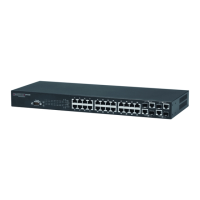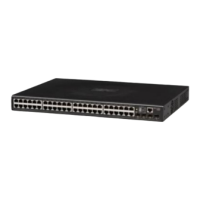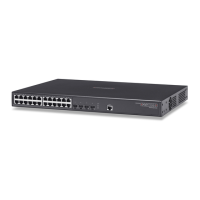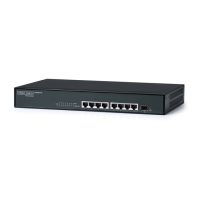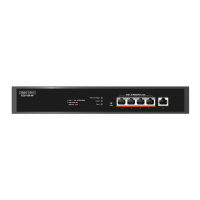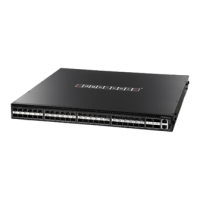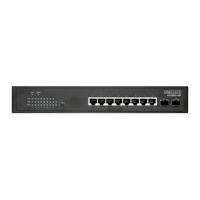C
HAPTER
6
| VLAN Configuration
IEEE 802.1Q Tunneling
– 181 –
4. After successful source and destination lookups, the packet is double
tagged. The switch uses the TPID of 0x8100 to indicate that an
incoming packet is double-tagged. If the outer tag of an incoming
double-tagged packet is equal to the port TPID and the inner tag is
0x8100, it is treated as a double-tagged packet. If a single-tagged
packet has 0x8100 as its TPID, and port TPID is not 0x8100, a new
VLAN tag is added and it is also treated as double-tagged packet.
5. If the destination address lookup fails, the packet is sent to all member
ports of the outer tag's VLAN.
6. After packet classification, the packet is written to memory for
processing as a single-tagged or double-tagged packet.
7. The switch sends the packet to the proper egress port.
8. If the egress port is an untagged member of the SPVLAN, the outer tag
will be stripped. If it is a tagged member, the outgoing packet will have
two tags.
Configuration Limitations for QinQ
◆ The native VLAN of uplink ports should not be used as the SPVLAN. If
the SPVLAN is the uplink port's native VLAN, the uplink port must be an
untagged member of the SPVLAN. Then the outer SPVLAN tag will be
stripped when the packets are sent out. Another reason is that it
causes non-customer packets to be forwarded to the SPVLAN.
◆ Static trunk port groups are compatible with QinQ tunnel ports as long
as the QinQ configuration is consistent within a trunk port group.
◆ The native VLAN (VLAN 1) is not normally added to transmitted frames.
Avoid using VLAN 1 as an SPVLAN tag for customer traffic to reduce the
risk of misconfiguration. Instead, use VLAN 1 as a management VLAN
instead of a data VLAN in the service provider network.
◆ There are some inherent incompatibilities between Layer 2 and Layer 3
switching:
■
Tunnel ports do not support IP Access Control Lists.
■
Layer 3 Quality of Service (QoS) and other QoS features containing
Layer 3 information are not supported on tunnel ports.
■
Spanning tree bridge protocol data unit (BPDU) filtering is
automatically disabled on a tunnel port.
General Configuration Guidelines for QinQ
1. Enable Tunnel Status, and set the Tag Protocol Identifier (TPID) value of
the tunnel access port (in the Ethernet Type field. This step is required
if the attached client is using a nonstandard 2-byte ethertype to
identify 802.1Q tagged frames. The default ethertype value is 0x8100.
(See "Enabling QinQ Tunneling on the Switch" on page 182.)

